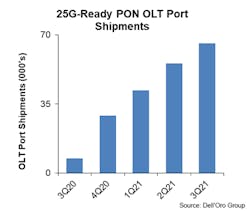As market awaits 50G PON, window opens for 25G PON: Dell’Oro analyst
While the ITU has decreed that single-channel 50G PON as defined within G.hsp.50pmd will be the next step beyond 10G PON options such as XGS-PON, a variety of factors likely will delay its availability until the second half of this decade, writes Dell’Oro broadband networking and home access analyst Jeff Heynen in a recent blog. That delay will provide a market opportunity for 25G PON alternatives, he believes.
Heynen notes that work is already underway on 50G PON technology. China Mobile has demonstrated 41 Gbps downstream and 16 Gbps upstream in a hybrid environment that included a 50G PON ONT and a 10G PON ONT. Nokia demonstrated 100G PON with Vodafone in a lab trial. Both of these 2021 exercises should be followed by additional proof-of-concept work this year, Heynen predicts.
But while China Mobile has stated its intention to begin deployments of 50G PON in 2023, Heynen notes that the China Academy of Information and Communications Technology (CAICT) doesn’t expect mass-market deployments until the latter half of this decade. Given that XGS-PON deployments are still ramping and a typical deployment cycle lasts approximately 5-7 years, Heynen believes CAICT’s scenario is a better yardstick than China Mobile’s plans – particularly since 50G PON will require DSP development.
25G PON timing is right
Which means that operators who require more than 10G before 2025 will need to turn elsewhere. And that’s where 25G PON can gain a foothold, Heynen writes. There are multiple scenarios where more than 10G might be required in the near future, he believes. These applications include serving businesses located in the middle of a residential fiber to the premises footprint as well as cable MSO networks that need something more robust than 10-Gbps DOCSIS Provisioning over EPON (DPoE) fiber networks for direct triple-play service delivery or for aggregation of Remote PHY and Remote MACPHY nodes in a Distributed Access Architecture (DAA).
In fact, the strongest demand over the next three to five years for 25G PON may arise from use cases beyond residential broadband services delivery, Heynen writes. For example, 25G PON could be used not only for business services delivery but to support 5G network deployments, he theorizes.
And 25G PON is available today. Heynen notes the creation of the 25GS-PON MSA, which includes AT&T, Chorus, Chunghwa Telecom, Cox Communications, NBN, Opticomm, and Proximus as members. Such a roster of interested operators would provide sufficient incentive for R&D in 25G PON, Heynen writes. (Such a catalyst is unnecessary for MSA member Nokia, which has already supplied 25G PON technology to Proximus and conducted trials of the technology with other operators not yet members of the MSA or delivered systems for deployment – see “Proximus turns up 25G PON link, commits to deployments” and, for example, “Openreach tests Nokia 25G PON.” Meanwhile, DZS has announced its intention to develop 25G PON technology as well.)
As a result of these tailwinds, sales of 25G-readly optical line terminals have grown steadily over recent quarters (see graph above). And this likely will continue, Heynen implies. “[M]any operators have clearly said that they simply can’t wait on a promising technology when they need to establish their market presence today. And so, the vendor ecosystem has responded again with options that can steer them down a path to success,” he concludes.
For related articles, visit the Business Topic Center.
For more information on FTTx technology and suppliers, visit the Lightwave Buyer’s Guide.
To stay abreast of fiber network deployments, subscribe to Lightwave’s Service Providers and Datacom/Data Center newsletters.
About the Author

Stephen Hardy
Editorial Director and Associate Publisher, Lightwave
Stephen Hardy is editorial director and associate publisher of Lightwave and Broadband Technology Report, part of the Lighting & Technology Group at Endeavor Business Media. Stephen is responsible for establishing and executing editorial strategy across the both brands’ websites, email newsletters, events, and other information products. He has covered the fiber-optics space for more than 20 years, and communications and technology for more than 35 years. During his tenure, Lightwave has received awards from Folio: and the American Society of Business Press Editors (ASBPE) for editorial excellence. Prior to joining Lightwave in 1997, Stephen worked for Telecommunications magazine and the Journal of Electronic Defense.
Stephen has moderated panels at numerous events, including the Optica Executive Forum, ECOC, and SCTE Cable-Tec Expo. He also is program director for the Lightwave Innovation Reviews and the Diamond Technology Reviews.
He has written numerous articles in all aspects of optical communications and fiber-optic networks, including fiber to the home (FTTH), PON, optical components, DWDM, fiber cables, packet optical transport, optical transceivers, lasers, fiber optic testing, and more.
You can connect with Stephen on LinkedIn as well as Twitter.
